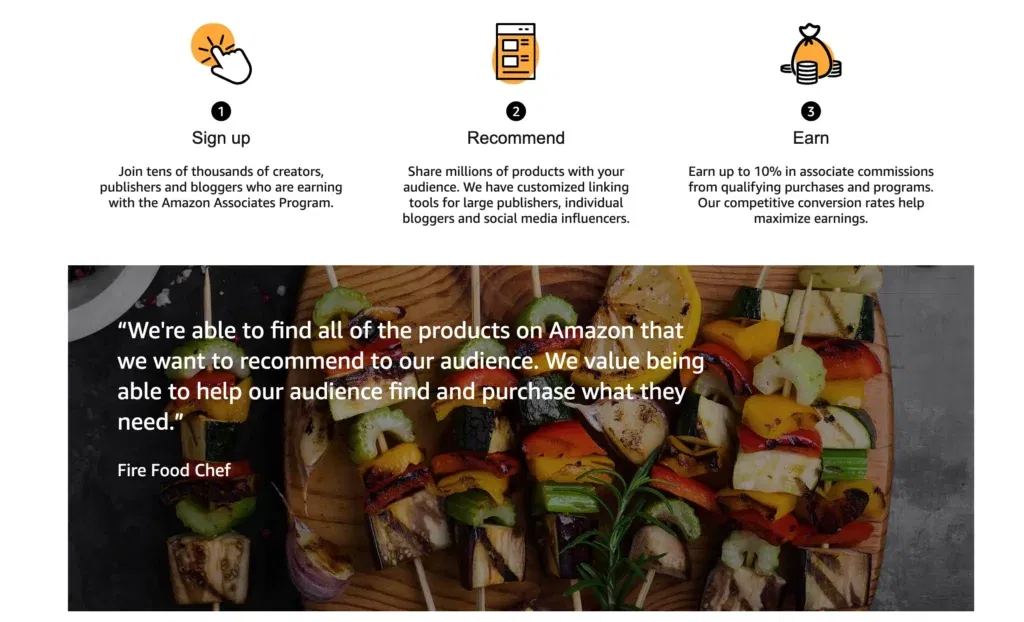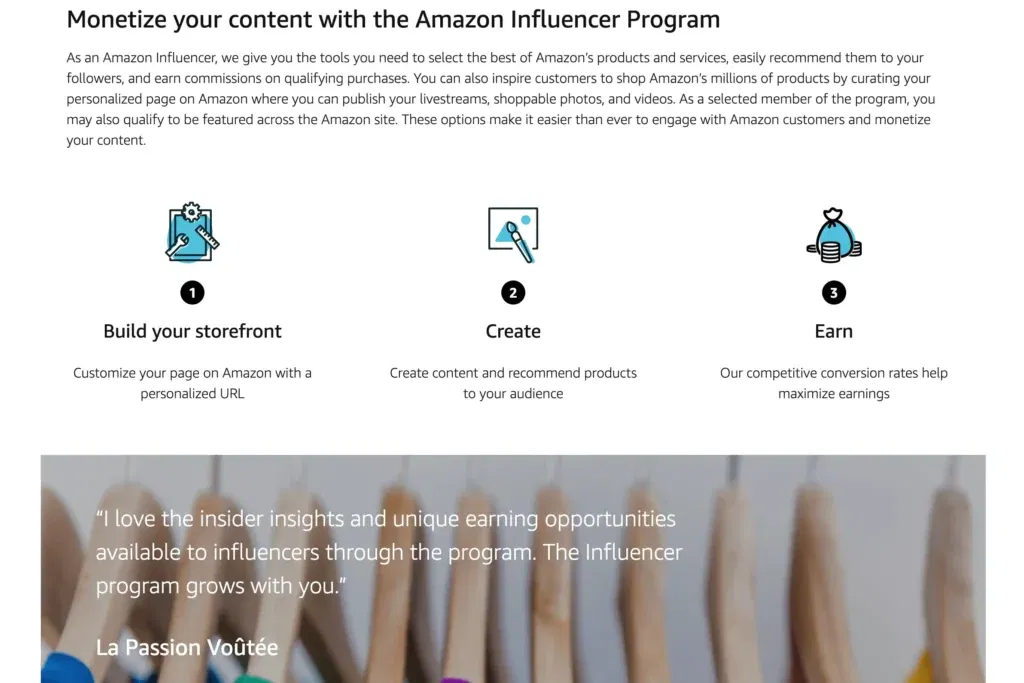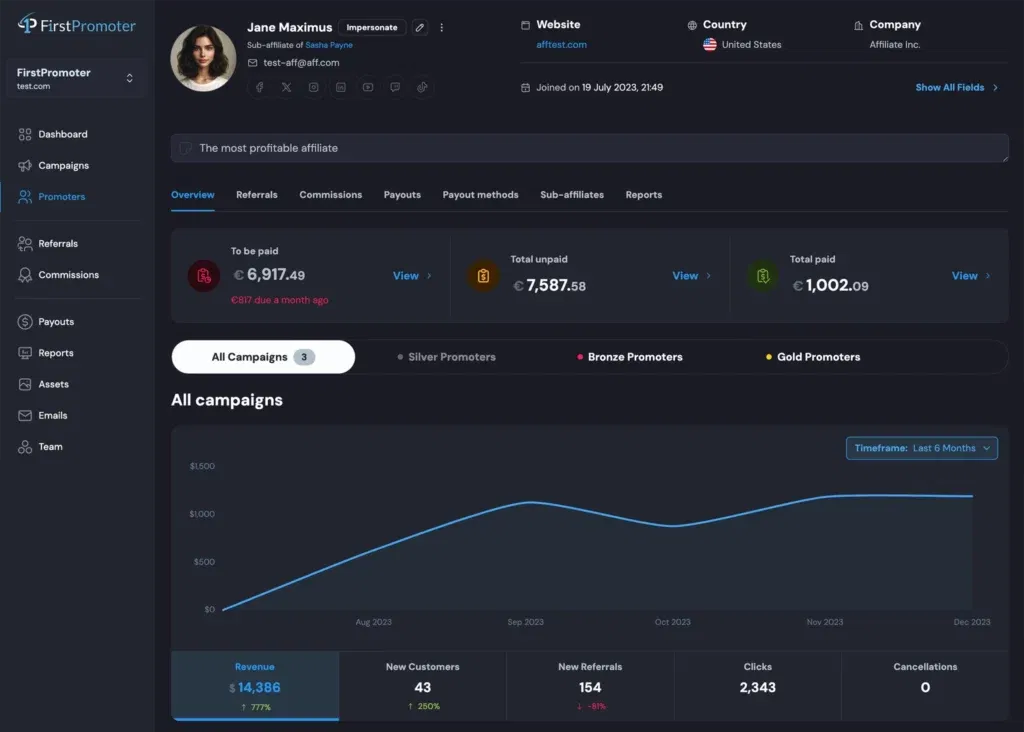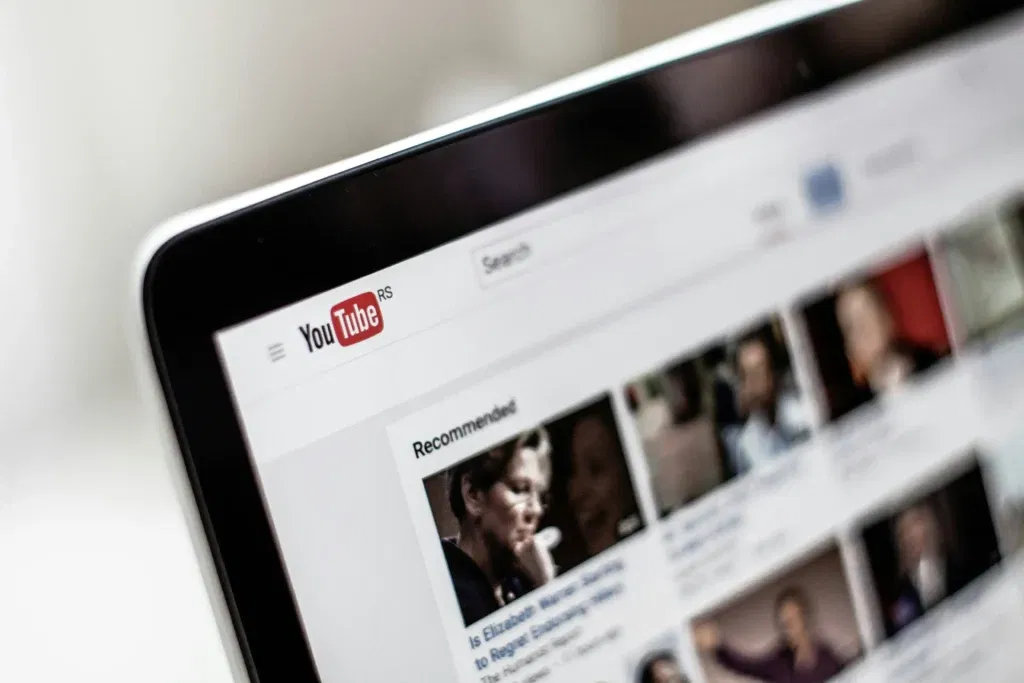Amazon associates drive niche traffic with detailed content, while influencers boost visibility via social media. Your choice depends on your brand goals.
If you pick the wrong program, you’ll waste valuable time and resources. Choose the right one with an effective strategy, and you can significantly boost sales.
In this post, you’ll learn the difference between Amazon Associates vs Influencer, how each program can benefit your brand, and practical steps to partner effectively with the right affiliates.
Table of Contents
What Is the Amazon Associate Program?

The Amazon Associates Program is the traditional Amazon affiliate marketing platform, where content creators—bloggers, website and mobile app owners, and YouTubers—promote Amazon products using affiliate links.
When someone sees the affiliate’s content, clicks a link, and makes a purchase, the associate earns a commission.
This means your products can be promoted by independent content creators who run niche blogs, review sites, or YouTube channels. For example, a pet brand’s toys might appear in a blog review about pets, driving buyers to its Amazon product listing.
What Is the Amazon Influencer Program?

The Amazon Influencer Program is a newer branch or extension of the affiliate program that targets social media creators with engaged audiences.
Amazon influencers create an Amazon storefront, a curated shop page of selected items, to promote on their social platforms.
For example, a beauty influencer can:
- Create a storefront of their favorite skincare products on Amazon
- Make videos using the products
- Share the Amazon storefront link with the videos on TikTok
This drives traffic to the product pages, and they earn commissions on products sold through the Amazon platform.
Key Differences Between Amazon Associates vs Influencer
To maximize your brand’s sales on Amazon, you must understand the key differences between Amazon Associates and the Amazon Influencer Program.
| Aspect | Amazon Associates | Amazon Influencers |
| Participants | Bloggers, website owners, and YouTubers | Social media influencers |
| Entry Requirements | Website or blog, three qualifying sales within 180 days | 1000+ followers on Instagram, TikTok, Facebook, or YouTube. Engagement review |
| Promotion Method | Affiliate links in blogs/videos | Amazon storefront link on social platforms |
| International Reach | Multiple marketplaces, international reach (with OneLink) | One storefront per market |
| Commission | 1%-20% commission rate | 1%-20% commission rate |
Participants
The Amazon Associates Program is for content creators, including bloggers, YouTubers, and website owners who produce in-depth content. Associates are ideal for e-commerce brands seeking niche audiences, such as a tech blog reviewing gadgets.
The Amazon Influencer Program targets social media influencers with engaged followings on major social media platforms like Instagram, TikTok, Facebook, and YouTube. Influencers are suitable for brands with visually appealing products, such as fashion brands.
Entry Requirements and Approval
Becoming an Amazon Associate is straightforward. You need a website or blog and must achieve three qualifying sales within 180 days to get approval.
The influencer program is more selective. Creators must have an active social media following (typically 1000+ followers) to be eligible. Amazon considers follower count, engagement rate, and content quality during their review process.
Link and Product Promotion
Associates use affiliate links to promote Amazon products in blog posts or YouTube videos. Their traffic typically comes from organic search, which can bring long-term value if the product ranks well.
Also, associates can generate affiliate links for virtually every product on Amazon. But they can’t share them on any “offline” channels (like PDFs) or in private (email or private conversations).
Influencers, on the other hand, can’t get affiliate links for specific products. Instead, they create a storefront with all their preferred products and promote the storefront link via social media posts, stories, live streams, or video tutorials.
An example is beauty influencer Kira’s Fashion Finds storefront, where she segments products by category (vacation, work wear, etc.) to make browsing easier for customers.
International Reach and Geo-Targeting
If you’re looking for international sales, the Amazon Associates and Influencer programs handle global audiences differently. Amazon Associates create affiliate links tied to specific marketplaces (e.g., amazon.com for the US, amazon.co.uk for the UK).
Without proper setup, international users clicking a US link may land on the wrong store, potentially losing sales. Fortunately, Amazon’s OneLink tool allows Associates to redirect users to the correct marketplace based on their location.
Amazon Influencers, however, are limited to one storefront per marketplace. This means that an influencer’s US storefront won’t automatically redirect UK shoppers to amazon.co.uk.
Some influencers use third-party services to perform OneLink’s function, while others create separate storefronts for each market and use tools like Linktree to display multiple links in their social media bios.
Commission Structure and Payments
Both programs offer the same commission rate, ranging from 1% to 20%, depending on product categories.
However, Associates get paid when customers order affiliate products within 24 hours of clicking. If customers add items to their cart but don’t immediately purchase, Associates can still get a referral commission if the purchase happens within 90 days before the cart expires.
Account Risks and Termination
Both Associates and Influencers are required to add a disclaimer to their content that they’re promoting Amazon products. Non-compliance risks the account for termination.
Additionally, if Associates don’t meet the three sales within 180 days requirement, their account will be terminated. Influencers must also continue to drive traffic to their storefront to keep their account active.
Choosing the Right Program for Your Brand

There are three key factors to consider when choosing between the Amazon Associates Program and the Amazon Influencer Program. However, some brands work with both. (You’ll learn when to use both shortly.) First, let’s discuss the three factors.
What’s Your Product?
Is your product visually appealing, or does it need to be seen in action to be sold? If yes, influencers are a better fit. Examples of niches that fall under this category are fashion and beauty, or anything that benefits from a product demo.
But if your product is something people are already searching for, Amazon Associates might be a better option. Associates catch buyers further down the funnel when they’re comparing options or ready to check out.
Who’s Your Audience?
Influencer audiences tend to be younger. Currently, millennials and Gen Z top the chart of social media usage. If your brand targets these generations, influencer content is an effective way to build trust.
Amazon Associates, on the other hand, lean into search intent. They cater to individuals who read product reviews, comparison blogs, or gift guides. Often, these people are ready to buy. If your audience has strong purchase intent, work with Associates.
Pro Tip: Conduct thorough research on your target audience to determine if they use search engines or social media more. This will give you insights on whether to work with influencers or Associates.
What’s Your Goal?
Are you trying to increase visibility or drive immediate conversions?
Influencers help spark interest and build awareness. Plus, you can reuse their branded content for ads. However, the Amazon Influencer Program supports visibility and sales.
Associates are better for direct conversions. In addition, if the content ranks well on search engines, it will continually drive traffic to your product page and increase sales.
Pro Tip: Optimize your product listings with high-quality images and clear, benefit-focused descriptions to improve conversions. Product listings that are likely to convert also attract Associates and Influencers.
When Do You Use Both Programs?
Some brands work with Amazon Associates to drive steady traffic and influencers for brand awareness, trust, and product discoverability. Together, they create a full-funnel affiliate strategy. Top of the funnel via influencer reach, then the bottom of the funnel through affiliate blogs and reviews.
Here’s a textbook example of how Amazon Associates and Influencers can work together in a full-funnel strategy:
Let’s say you sell beauty products, such as a new facial moisturizer.
- Top of Funnel: An Amazon Influencer shares a short reel on Instagram showing how it feels, how it absorbs, and how it fits into their skincare routine. Their content sparks interest and plants the seed of inspiration.
- Middle of Funnel: A potential customer already uses a different moisturizer. So before switching, they do what most savvy shoppers do: Google a comparison.
- Bottom of Funnel: That’s where your Amazon Associate steps in. They’ve written a blog post titled “Brand A Moisturizer vs Brand B: Which One’s Better for Oily Skin?” They break down ingredients, texture, price, and results. And right there in that blog post is your product with an affiliate link.
Now the customer’s ready to buy. They might purchase through either the blog link or go back to the influencer’s Amazon storefront. Either way, your brand wins.
You generated interest at the top of the funnel, built trust in the middle, and captured the sale at the bottom. That’s the power of combining both programs.
How to Find Amazon Associates and Influencers
Many content creators join the Amazon Affiliate Program (Associates or Influencers) to promote products they use or find compelling. But with over 9 million sellers on Amazon, your product is just one in a massive sea of options.
So, instead of waiting for affiliates to pick your products, let’s discuss how you can discover them.
1. Search Amazon’s Influencer Storefronts

Search hashtags like “#FoundItOnAmazon” or “#AmazonFinds” on Instagram, TikTok, or Google to discover influencers’ storefronts. Amazon Influencers run these storefronts and often feature curated product lists by niche.
Look for creators in your niche who promote products and reach out to them with your proposal. You can send samples for them to review.
2. Use YouTube for Amazon Associates
On YouTube, search for Amazon Associates using “[insert your niche] Amazon review” or “best [insert product type] on Amazon.” Then, check video descriptions for disclaimers, such as “As an Amazon Associate, I earn from qualifying purchases,” to confirm their affiliation.
Browse through several to find one that fits your brand tone and style. Then, reach out. If you can’t find their email, add a comment telling them you’d like to partner.
3. Check Your Own Customers’ Content
Your existing customers might already be affiliates. Scan social media posts or tagged content for brand mentions. If you find customers who have used your product and have Amazon affiliate links, they’re a warm lead. You can reuse their content, incentivize them to do more, or invite them to your in-house affiliate program.
4. Partner with Affiliate Marketing Agencies
Finding the right Associates/Influencers and managing the relationships takes time. You can imagine how long it’ll take to conduct the searches I discussed above.
So, instead of wasting valuable time, consider partnering with agencies in the affiliate marketing business, like Vivian Agency. They handle affiliate recruitment, manage outreach, track performance, and drive sales and growth.
Amazon Associates Program vs Amazon Influencer Program: Final Verdict
In the Amazon Associates vs Influencer debate, there’s no winner. Both programs work in different ways. Partner with Influencers for product discoverability or to reach younger audiences, then Associates to convert search-driven shoppers.
What part of your funnel needs the most support?
P.S. I can help you answer that question and plan your Amazon affiliate strategy in a one-on-one session. Book a call now.




